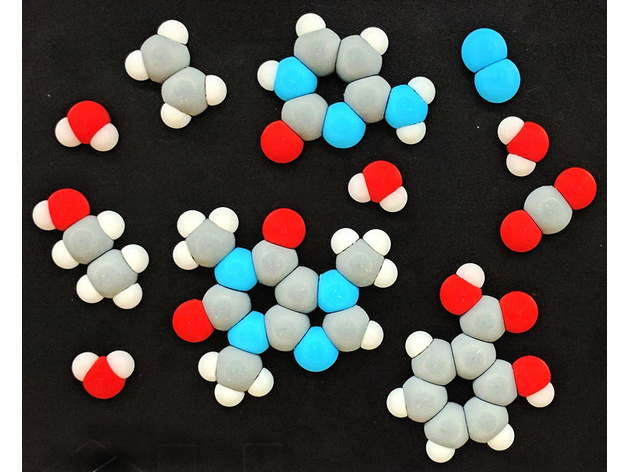
Molecular modeling fridge magnet set
thingiverse
Molecular modelling fridge magnet set Molecules are groups of atoms bonded together, ranging between the small, such as molecular hydrogen with just two atoms, or the massive, such as DNA containing billions of atoms! Chemistry modelling sets can help us visualize molecules in meaningful ways. This kit is designed with 3D printing in mind and to be displayed on a flat surface, much like we draw molecules on paper. By inserting small magnets, you can also attach your models to a fridge or any other magnetic surface. With just a few dozen atoms pieces, the number of unique molecules you can make is simply staggering, totalling in the millions. The shape or geometry of the molecule also depends on the hybridization of the atoms within it. For example, carbon with sp3 hybridization (as in methane) can have bonds to 4 neighbouring atoms while carbon with sp2 hybridization (as in benzene) can only have 3. As the angles between these bonds are different, be sure to have the right atom types for the molecule you are making. (More about that in the general notes below). Please note, as this modeling set is restricted in 2D, the bond angles are not necessarily accurate in their 3D sense. As for the atom types we have (so far!):Hydrogen: H_2D Carbon:Csp3_square_2D: sp3 carbon than can make 4 bonds in square geometry.Csp3_methyl_2D: sp3 carbon distorted for modelling methyl side-chains.Cps2_2D: sp2 carbon that can make 3 bonds, found in benzene and alkenes.Cps2_BC_L_2D: special bicyclic sp2 carbon that can make 3 bonds, found in the intersection of six and five membered rings as found in caffeine. (Left orientation)Cps2_BC_R_2D: special bicyclic sp2 carbon that can make 3 bonds, found in the intersection of six and five membered rings as found in caffeine. (Right orientation)Csp2_5C_2D: sp2 cyclic carbon found in 5-membered rings such as furan.Csp_2D: sp carbon that can make 2 bonds as found in carbon dioxide and alkynes. Nitrogen:Nsp2_2D: sp2 nitrogen that make 3 bonds (can also be used for sp3 N in ammonia)Nsp2_pyridine_2D: sp2 nitrogen found in pyridine.Nsp2_5C_imidazole_2D: sp2 nitrogen in imidazole with lone pair.Nsp2_5C_2D: sp2 nitrogen in imidazole with hydrogen bonded.Nsp_2D: sp nitrogen as in atmospheric N2. Oxygen:Osp3_2D: sp3 oxygen found in hydroxyl groups and water. (can also be used for furan)Osp2_2D: sp2 oxygen used for carbonyl groups and molecular oxygen. Also included a plus and arrows for depicting chemical equations. Recommended atom colours For the atom colours, I generally recommend following the guidelines set byhttps://en.wikipedia.org/wiki/CPK_coloring ie) hydrogen (white), carbon (black or dark gray), nitrogen(blue), oxygen(red), sulphur(yellow). General notes Atoms should simply snap together by pushing them together at their bond interface. They also easily come apart by bending them. If you want to turn your model into into a fridge magnet set, read the post-printing section below. As this modelling set is a 2-dimensional representation of molecules, many complicated 3-dimensional molecules can not be easily represented. Important notes for making cyclic structures! There are subtle bond angle differences in the atom types. Make sure that when making a ring structure that the inner-symbols on the flat surface side match. For hexagonal rings, make sure the inner angles have an "X" symbol. For 5 membered rings, there should be a "P" symbol. Making a purine molecule (which has a joined six and five membered rings) can be tricky as it requires the special "Cps2_BC_L" and "Cps2_BC_R" carbons at the junction of the rings. Make sure the "X"s are towards the center of hexagonal ring, and the "P"s towards the center of the pentagonal ring. Print Settings Printer Brand: Zortrax Printer: Zortrax M200 Resolution: 0.09mm Infill: 10% Notes: Print the atom pieces with the flat surface down. Try print with the highest resolution possible to give the best finish. The atom pieces should snap together cleanly. To break the bonds try bending gently from the flat side. Post-Printing Turning your model into a fridge-magnet model. To make fridge magnets you will need: 3 mm diameter cylindrical neodymium magnets either 1 or 2 mm long. (One for each "fridge magnet" atom; easy to buy cheap sets of 100 or more online) A 3mm drill bit Some hobby glue to stick the magnets in place. The central hole on the flat side of each atom piece has a 3mm diameter and should snugly fit one small magnet just by pushing the magnet into the hole. However, due do the differences in print quality, you may have difficulty doing this. If the hole is too small, gently drill out the hole twirling the drill bit with your fingers. If you find that when you put the atom on the fridge, and the magnet falls out, you may want to use a drop of glue in the hole to hold the magnet in place. Make sure to let the glue dry! You don't necessarily need magnets for every atom for the molecule to stick to the fridge. Good luck!
With this file you will be able to print Molecular modeling fridge magnet set with your 3D printer. Click on the button and save the file on your computer to work, edit or customize your design. You can also find more 3D designs for printers on Molecular modeling fridge magnet set.
